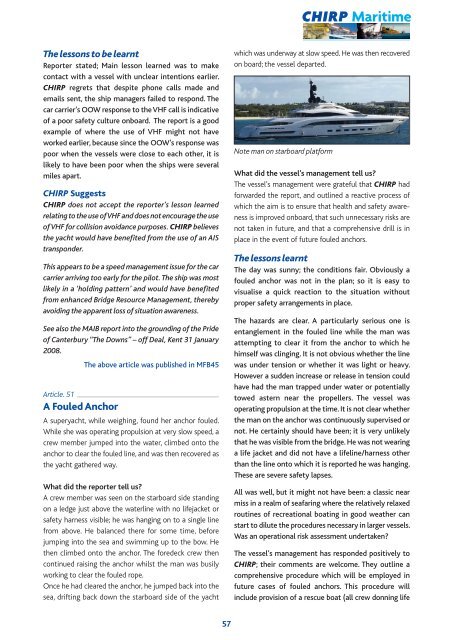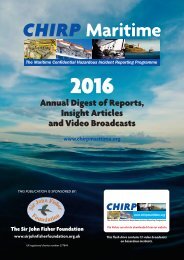CHIRP annual digest 2016 6th
You also want an ePaper? Increase the reach of your titles
YUMPU automatically turns print PDFs into web optimized ePapers that Google loves.
<strong>CHIRP</strong> Maritime<br />
The lessons to be learnt<br />
Reporter stated; Main lesson learned was to make<br />
contact with a vessel with unclear intentions earlier.<br />
<strong>CHIRP</strong> regrets that despite phone calls made and<br />
emails sent, the ship managers failed to respond. The<br />
car carrier’s OOW response to the VHF call is indicative<br />
of a poor safety culture onboard. The report is a good<br />
example of where the use of VHF might not have<br />
worked earlier, because since the OOW’s response was<br />
poor when the vessels were close to each other, it is<br />
likely to have been poor when the ships were several<br />
miles apart.<br />
<strong>CHIRP</strong> Suggests<br />
<strong>CHIRP</strong> does not accept the reporter’s lesson learned<br />
relating to the use of VHF and does not encourage the use<br />
of VHF for collision avoidance purposes. <strong>CHIRP</strong> believes<br />
the yacht would have benefited from the use of an AIS<br />
transponder.<br />
This appears to be a speed management issue for the car<br />
carrier arriving too early for the pilot. The ship was most<br />
likely in a ‘holding pattern’ and would have benefited<br />
from enhanced Bridge Resource Management, thereby<br />
avoiding the apparent loss of situation awareness.<br />
See also the MAIB report into the grounding of the Pride<br />
of Canterbury “The Downs” – off Deal, Kent 31 January<br />
2008.<br />
Article. 51<br />
A Fouled Anchor<br />
The above article was published in MFB45<br />
A superyacht, while weighing, found her anchor fouled.<br />
While she was operating propulsion at very slow speed, a<br />
crew member jumped into the water, climbed onto the<br />
anchor to clear the fouled line, and was then recovered as<br />
the yacht gathered way.<br />
What did the reporter tell us?<br />
A crew member was seen on the starboard side standing<br />
on a ledge just above the waterline with no lifejacket or<br />
safety harness visible; he was hanging on to a single line<br />
from above. He balanced there for some time, before<br />
jumping into the sea and swimming up to the bow. He<br />
then climbed onto the anchor. The foredeck crew then<br />
continued raising the anchor whilst the man was busily<br />
working to clear the fouled rope.<br />
Once he had cleared the anchor, he jumped back into the<br />
sea, drifting back down the starboard side of the yacht<br />
which was underway at slow speed. He was then recovered<br />
on board; the vessel departed.<br />
Note man on starboard platform<br />
What did the vessel’s management tell us?<br />
The vessel’s management were grateful that <strong>CHIRP</strong> had<br />
forwarded the report, and outlined a reactive process of<br />
which the aim is to ensure that health and safety aware -<br />
ness is improved onboard, that such unnecessary risks are<br />
not taken in future, and that a comprehensive drill is in<br />
place in the event of future fouled anchors.<br />
The lessons learnt<br />
The day was sunny; the conditions fair. Obviously a<br />
fouled anchor was not in the plan; so it is easy to<br />
visualise a quick reaction to the situation without<br />
proper safety arrangements in place.<br />
The hazards are clear. A particularly serious one is<br />
entanglement in the fouled line while the man was<br />
attempting to clear it from the anchor to which he<br />
himself was clinging. It is not obvious whether the line<br />
was under tension or whether it was light or heavy.<br />
However a sudden increase or release in tension could<br />
have had the man trapped under water or potentially<br />
towed astern near the propellers. The vessel was<br />
operating propulsion at the time. It is not clear whether<br />
the man on the anchor was continuously supervised or<br />
not. He certainly should have been; it is very unlikely<br />
that he was visible from the bridge. He was not wearing<br />
a life jacket and did not have a lifeline/harness other<br />
than the line onto which it is reported he was hanging.<br />
These are severe safety lapses.<br />
All was well, but it might not have been: a classic near<br />
miss in a realm of seafaring where the relatively relaxed<br />
routines of recreational boating in good weather can<br />
start to dilute the procedures necessary in larger vessels.<br />
Was an operational risk assessment undertaken?<br />
The vessel’s management has responded positively to<br />
<strong>CHIRP</strong>; their comments are welcome. They outline a<br />
comprehensive procedure which will be employed in<br />
future cases of fouled anchors. This procedure will<br />
include provision of a rescue boat (all crew donning life<br />
57



